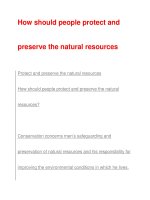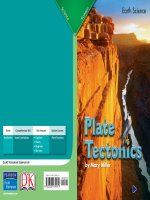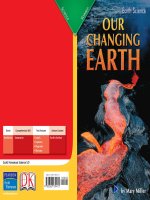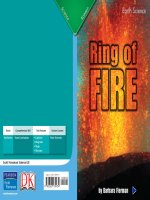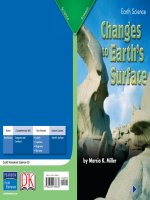3 9 earths natural resources (earth science)
Bạn đang xem bản rút gọn của tài liệu. Xem và tải ngay bản đầy đủ của tài liệu tại đây (2.8 MB, 10 trang )
Genre
Nonfiction
Comprehension Skill
Compare and
Contrast
Text Features
• Captions
• Labels
• Glossary
Science Content
Natural Resources
Scott Foresman Science 3.9
ISBN 0-328-13833-9
ì<(sk$m)=bdid d< +^-Ä-U-Ä-U
Vocabulary
conservation
natural resources
nonrenewable resources
recycle
renewable resources
What did you learn?
1. Are trees a renewable or
nonrenewable resource? Why?
2. Why are coal and oil nonrenewable
resources?
3. Name some things that can
by Raquel Martin
be recycled.
4.
In this book
you have read about how planting
trees can help conserve some
natural resources. Write to explain
what these resources are and how
they are affected.
5.
Compare and Contrast What
happens to trash when it is thrown
away? What happens to trash when
it is recycled?
Picture Credits
Every effort has been made to secure permission and provide appropriate credit for photographic material.
The publisher deeply regrets any omission and pledges to correct errors called to its attention in subsequent editions.
Photo locators denoted as follows: Top (T), Center (C), Bottom (B), Left (L), Right (R), Background (Bkgd).
1 Corbis; 2 Getty Images; 4 (TL) Corbis, (TR) Chris Ballentine/Alamy Images; 5 (CR) Royal Museum of Scotland,
Edinburgh/DK Images; 6 (L) Getty Images; 7 Reuters/Corbis; 9 Jay Syverson/Corbis; 10 Getty Images;
12 Bill Bachmann/Alamy Images.
Scott Foresman/Dorling Kindersley would also like to thank: 5 (TR, BR) Natural History Museum, London/DK Images;
13 (TL) Stephen Oliver/DK Images.
Unless otherwise acknowledged, all photographs are the copyright © of Dorling Kindersley, a division of Pearson.
ISBN: 0-328-13833-9
Copyright © Pearson Education, Inc. All Rights Reserved. Printed in the United States of America.
This publication is protected by Copyright, and permission should be obtained from the publisher prior to any
prohibited reproduction, storage in a retrieval system, or transmission in any form by any means, electronic,
mechanical, photocopying, recording, or likewise. For information regarding permission(s), write to
Permissions Department, Scott Foresman, 1900 East Lake Avenue, Glenview, Illinois 60025.
3 4 5 6 7 8 9 10 V010 13 12 11 10 09 08 07 06 05
What Resources Are
Resources are materials that help meet
the needs of living things. Natural resources
are important materials from Earth that
living things need.
Trees are one example of a natural resource.
Trees give people the material needed to make
many things. Wood is used to make lumber for
building homes. Wood is also used to make
pencils and even paper.
2
Some other natural resources are water,
soil, air, and sunlight. All these resources
come straight from nature. These natural
resources are used every day. You are always
breathing air. You always need to drink water.
Plants and trees need sunlight, soil, water,
and air to grow.
What natural resources is this farm
using to grow crops?
3
Resources We
Cannot Replace
Crops ready for harvesting
Plowed field ready for planting
Resources We Can Replace
Some natural resources can be easily replaced.
These are called renewable resources. We often
plant new trees to replace the ones we cut down.
If we eat all the crops that farmers grow one year,
more can be planted the next year.
4
There are some natural
resources that we cannot
make again. Earth can run
out of many resources.
Once we use them up, they
are gone. These resources
are called nonrenewable
resources.
Many nonrenewable
resources are used for very
important tasks. A lot of
them, such as natural gas,
oil, and coal, are used as
fuel. Once these resources
are used up, we cannot make
any more of them.
Some resources are
always available on Earth.
Sunlight, air, and water
cannot be used up.
Iron
Coal
Oil
5
Protecting
Natural
Resources
It is important to find ways to save
our natural resources. We do not
want to use them all up. People have
learned how important it is to care for
our natural resources. By doing that,
we will have them in the future.
Conservation is the
careful use of natural
resources so they
are not wasted or
used up. When you
practice conservation,
you use only what you
need. You also make
sure not to waste anything.
Turning the lights off when
you leave the room and turning off
the water while you brush your teeth
help conserve electricity and water.
6
This new car runs on electricity and gasoline. It creates less
air pollution than old cars, which use up a lot of gasoline.
There are many ways people conserve resources.
Car companies are making new cars that run on
both electricity and gasoline. They are also
changing the way cars that use gasoline work. Now
some cars use less. This helps conserve gasoline.
Gasoline is a nonrenewable resource. Using less
gas also causes less air pollution. This way, air
can stay clean for longer. But the easiest way to use
less gasoline is to take fewer trips in the car.
7
Sometimes conserving resources means using
a little less of something. Next time you buy
something at the store, you could use your
backpack to carry it home instead of taking
a new paper bag. This way, fewer paper bags are
used. Then fewer trees need to be cut down to
make them. Ask your mom or dad to bring back
the bags they use at the grocery store each time
they go. This saves paper too.
Planting trees by the side of a river protects its banks.
Take old paper or
plastic bags, or your
own backpack, when
you go shopping.
8
One way to help conserve water and keep
it clean is to plant trees along riverbanks.
Tree roots grow deep into the moist soil along
a riverbank. This makes it harder for soil to
wear away in the wind or rain. The trees
also help keep soil from sliding down into
the water. This kind of conservation helps
keep water clean. It also adds more trees
to Earth. It keeps the soil healthy too. Clean
water and soil are very important to animals
that make their homes near rivers.
9
What We Do with Trash
We make many things out of natural resources.
Aluminum cans, plastic bags, newspapers,
aluminum foil, and glass bottles are all made from
natural resources. Many of these things are used
every day. What happens to them after we use
them? We throw them out in the trash. But where
does all our trash go?
We bury a lot of our trash in landfills. A landfill
is a place where a giant hole is dug into the ground
and covered with a liner. Our trash is put on top
of the liner so it does not sink into the soil.
Our trash never really goes away, and we are
running out of places to bury it. Some places
have tried burning trash instead. But burning
trash can cause air pollution.
Where does your trash go?
Can you think of ways to
cut down on the amount
of trash that you make?
10
11
Ways to Use
Resources Again
A different way to solve our trash problem
is to make less trash. You can help do this every
day. Maybe you could use empty jars to hold
things such as pens and pencils. Or when you have
finished drinking a can of juice, do not throw it
in the trash. Recycle it.
When we recycle something, it gets changed
so we can use it again. For example, you can recycle
your plastic juice containers. They can go to a
recycling center. There they might be made into
plastic parts that will be put in a new computer!
There are separate recycling
bins for paper, glass,
aluminum, and plastic.
12
Used aluminum foil
Old aluminum can
Old aluminum
is made into new
aluminum cans.
New aluminum can
Recycling is the reason people put their trash
into different piles. Newspapers get recycled.
Plastic, glass, and aluminum get recycled too.
These things do not go to a landfill and take up
space. They go to a recycling center.
When an aluminum can goes to a recycling
center, it is chopped into little pieces. Very hot air
takes any paint off the metal scraps. Then these
scraps are melted in an even hotter furnace. The
melted aluminum is poured into molds, and new
cans are made. These cans may end up back at the
recycling center once they’ve been used again.
13
How to Recycle
People have been recycling for a long time.
Your parents probably do it, and you can too.
When you help with the shopping, you can
tell your parents that it is a good idea to pick
things with a recycling symbol on the package.
This means that the box, jar, or can that the food
comes in was made from recycled materials.
Even your clothing can be made from recycled
material. Everything from wrapping paper to car
tires can be made from recycled goods today.
Remember the three Rs. Reduce the amount
of natural resources you use and the amount
of trash you create. Reuse as many things as you
can. Recycle all the things that you can. This way,
you are really helping the planet.
Collect things made of plastic,
glass, paper, and aluminum.
All these things can be recycled.
Look for recycling symbols
such as this one when
you are shopping.
Reduce your trash. Reuse or
recycle as many things
as possible.
14
15
What did you learn?
Vocabulary
Glossary
conservation
natural resources
conservation
nonrenewable resourcesprotecting natural
resources from being
recycle
renewable resources used up or wasted
1. Are trees a renewable or
nonrenewable resource? Why?
natural resources
3. Name some things that can
be recycled.
materials supplied
by nature that living
things need
2. Why are coal and oil nonrenewable
resources?
4.
In this book
you have read about how planting
trees can help conserve some
natural resources. Write to explain
what these resources are and how
they are affected.
5.
Compare and Contrast What
happens to trash when it is thrown
away? What happens to trash when
it is recycled?
nonrenewable resources natural resources
that cannot
be replaced
Picture Credits
Every effort has been made to secure permission and provide appropriate credit for photographic material.
The publisher deeply regrets any omission and pledges to correct errors called to its attention in subsequent editions.
recycle
to change or treat
Photo locators denoted as follows: Top (T), Center (C), Bottom (B),
Left (L), Right (R), Background
(Bkgd).it
something
so that
1 Corbis; 2 Getty Images; 4 (TL) Corbis, (TR) Chris Ballentine/Alamy Images; 5 (CR) Royal Museum of Scotland,
can
be used
Edinburgh/DK Images; 6 (L) Getty Images; 7 Reuters/Corbis; 9 Jay
Syverson/Corbis;
10 Getty again
Images;
12 Bill Bachmann/Alamy Images.
Scott Foresman/Dorling Kindersley would also like to thank: 5 (TR, BR) Natural History Museum, London/DK Images;
13 (TL) Stephen Oliver/DK Images.
renewable resources
natural resources that
can be replaced
Unless otherwise acknowledged, all photographs are the copyright © of Dorling Kindersley, a division of Pearson.
ISBN: 0-328-13833-9
Copyright © Pearson Education, Inc. All Rights Reserved. Printed in the United States of America.
This publication is protected by Copyright, and permission should be obtained from the publisher prior to any
prohibited reproduction, storage in a retrieval system, or transmission in any form by any means, electronic,
mechanical, photocopying, recording, or likewise. For information regarding permission(s), write to
Permissions Department, Scott Foresman, 1900 East Lake Avenue, Glenview, Illinois 60025.
3 4 5 6 7 8 9 10 V010 13 12 11 10 09 08 07 06 05
16
